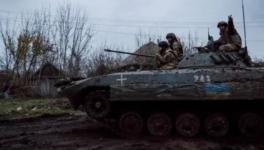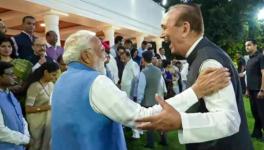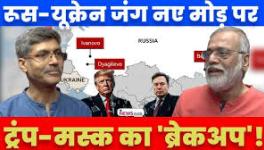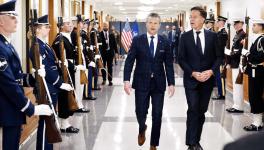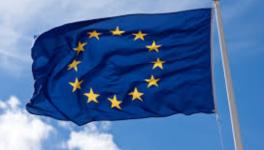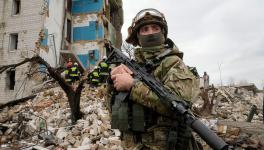Ukraine War: The Short View
Ukraine President Vladimir Zelensky has somewhat eased the suspense by his remark to the Western media on Thursday that his army needs to wait and still needs “a bit more time” to launch the much-anticipated counter-offensive against Russian forces.
He acknowledged that Ukraine’s combat brigades are “ready” but would reason that the army still needed “some things,” including armoured vehicles that were “arriving in batches” from NATO countries.
Zelensky proffered the explanation that “we can go forward, and, I think, be successful. But we’d lose a lot of people. I think that’s unacceptable. So, we need to wait. We still need a bit more time.”
However, Zelensky’s claim that Ukraine’s military still needed some equipment is at variance with the assertive statement by western officials. None other than NATO chief Jens Stoltenberg said a fortnight ago, one full week after returning from Kiev after talks with Zelensky and his top aides, that NATO deliveries constituted more than 98% of the combat vehicles promised to Ukraine.
Stoltenberg added, “In total, we have trained and equipped more than nine new Ukrainian armoured brigades. This will put Ukraine in a strong position to continue to retake occupied territory.”
Last Tuesday, US Secretary of State Antony Blinken broadly endorsed what Stoltenberg said, during a joint press conference with the visiting UK Foreign Secretary James Cleverly, while also taking care to add a caveat:
“They (Ukrainian military) have in place … what they need to continue to be successful in regaining territory that was seized by force by Russia… It’s not only the weapons; it’s the training. It’s making sure that the Ukrainians can maintain the systems that we provide them, and it’s important, of course, that they have the right plans, again, to be successful.”
Cleverly agreed with the drift of what Blinken said but gave a political perspective to it. That is perfectly acceptable, since this is a war that is more political than military.
Cleverly said people shouldn’t expect a film-like counteroffensive from Kiev. He cautioned: “The real world doesn’t work like that. I hope and expect they will do very, very well, because whenever I’ve seen the Ukrainians, they have outperformed expectations… (but we) have to be realistic. This is the real world. This is not a Hollywood movie.”
To be fair, Stoltenberg also had cautioned on a parallel track, saying that “we should never underestimate Russia.” He claimed that Russia was mobilising more ground forces and is “willing to send in thousands of troops with very high casualty rates.”
Perhaps, the salience of what these three officials were harping on was that no matter the outcome of the planned Ukrainian offensive, NATO countries “must stay the course and continue to provide Ukraine with what it needs to prevail” in the face of what appears to be a prolonged conflict. Indeed, both Blinken and Cleverly are in sync with what Stoltenberg said.
In fact, even as the two foreign ministers spoke, on the same day, the US announced an additional $1.2 billion in aid to Ukraine intended to bolster air defences and keep up ammunition supplies.
There is a lot of angst in recent weeks as to whether a Ukrainian counter-offensive is indeed in the pipeline. The answer is a categorical ‘yes’. As to its timing, it seems there could be a difference of opinion.
Weather conditions are no longer an insurmountable factor and Zelensky’s western sponsors want him to get going with the offensive — the sooner the better. Their calculus is that the offensive has a reasonable chance of success, which would go a long way in placating the Western domestic opinion that such costly support for Ukraine was after all not going into a bottomless pit.
Second, the offensive is useful politically to shore up European opinion. In fact, the European Commission headed by its president (and an ardent Atlanticist), Ursula von der Leyen has just confirmed that the EU is preparing to take initial steps toward adopting methods of US sanctions and impose extraterritorial (collateral) punitive measures on enterprises of third countries including those in the United Arab Emirates and possibly in Turkey.
It seems the EU will first focus on the resale of sanctioned EU goods to Russia. In future, enterprises will be punished even if they are not based within the EU and, therefore, are not subject to EU norms.
Indeed, such extraterritorial implementation of one’s own system of norms will be in violation of international law — and the EU itself had officially held that position up until recently — but Von der Leyen is pushing for a revised “rules-based order” to add a new cutting edge to the western strategy to weaken Russia.
The underlying assumption is that the sanctions will weaken the Russian economy and create social disaffection. It only goes to show that no matter the fate of Zelensky’s counter-offensive, there isn’t going to be any let-up in the proxy war against Russia. On the other hand, no one can blame President Biden for a Ukrainian defeat, either.
However, there is a catch: Zelensky also has his priorities — first and foremost, his own political survival. He knows that his narrative about an impending Russian defeat, et al, has unravelled and he may become the fall guy in any blame game in the aftermath of a crushing defeat in the crucial weeks or months ahead.
Indeed, the Game of Thrones in Kiev is nearing a critical stage. Sensing danger, Zelensky is dithering. He is buying time. (General Valerii Fedorovych Zaluzhnyi, chief of Ukraine’s armed forces, skipped a NATO meeting!) But how long can Zelensky push back the mounting US and NATO pressure to launch the offensive? His exit strategy could have been to open a line to Moscow but that option no longer exists.
On its part, Russia is doing brilliantly well to keep its cards close to its chest. Russia has the capability to launch a “big arrow” offensive towards the Dnieper but the Kremlin's preference is to continue to grind down the Ukrainian military — a strategy that proved cost-effective in human and material terms, productive, and sustainable.
Depending on the trajectory of the Ukrainian offensive, therefore, Russia has the option to switch to a massive attack to pulverise the adversary. Presently, its heavy bombing campaign is intended to create shock and awe in Kiev and despondency in the European capitals, and to degrade Ukraine’s mobilisation. The West is kept guessing about the Russian intentions.
MK Bhadrakumar is a former diplomat. He was India’s ambassador to Uzbekistan and Turkey. The views are personal.
Get the latest reports & analysis with people's perspective on Protests, movements & deep analytical videos, discussions of the current affairs in your Telegram app. Subscribe to NewsClick's Telegram channel & get Real-Time updates on stories, as they get published on our website.










